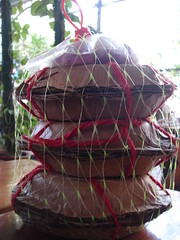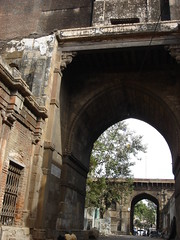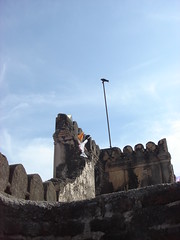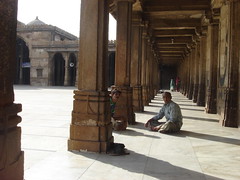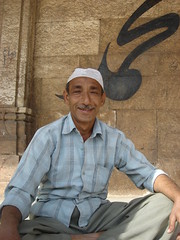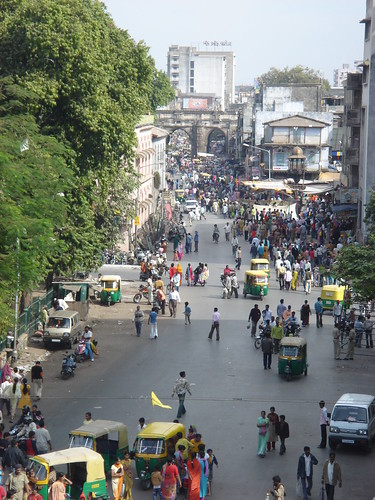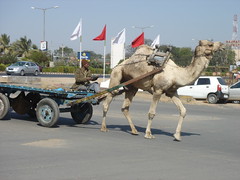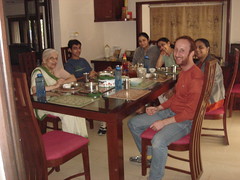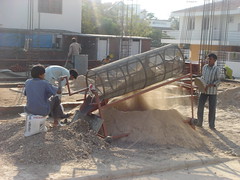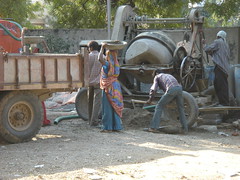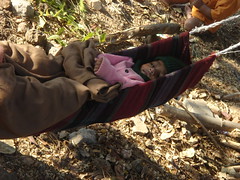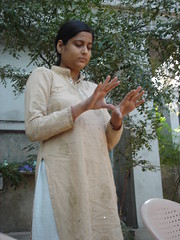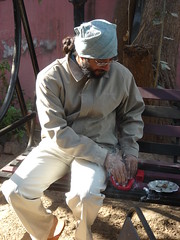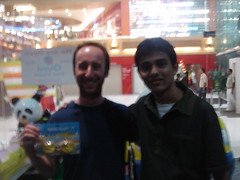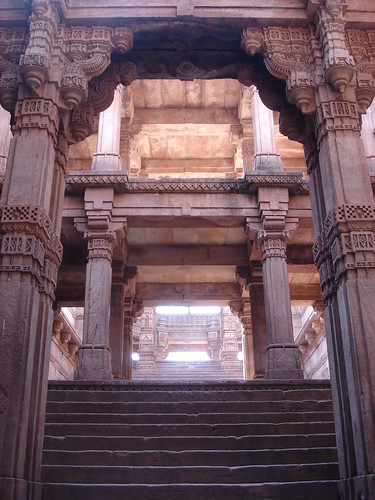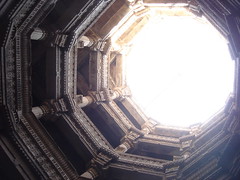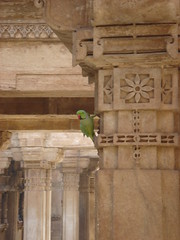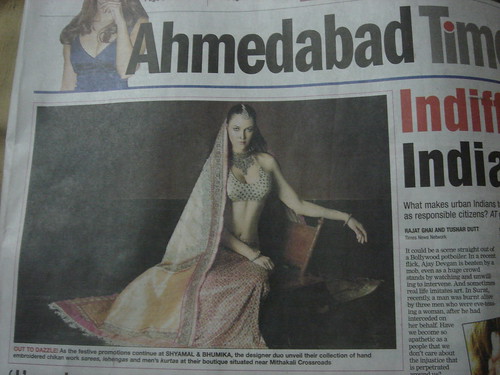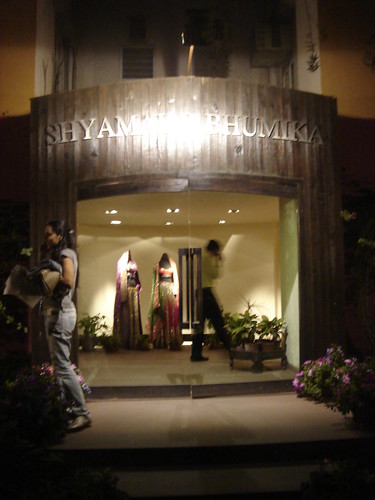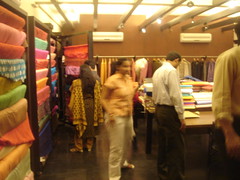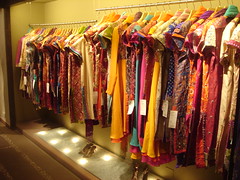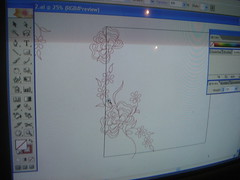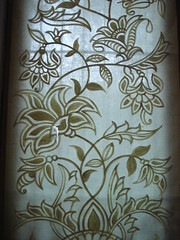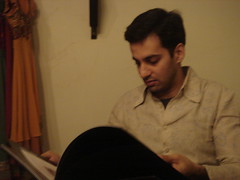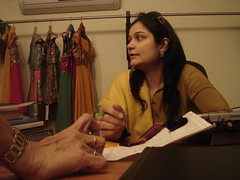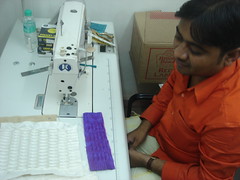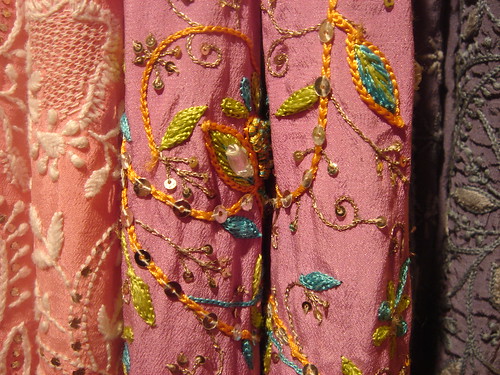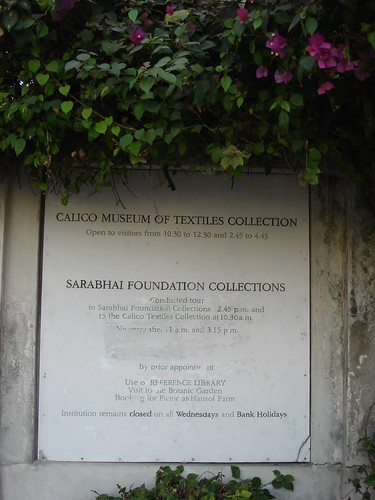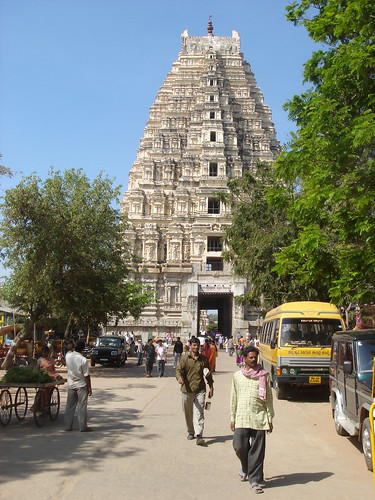
Below, we find one of many kiosks in the many bazaar. This one is painted an eye catching blue hue. The daughter of the operator is opening the door to join her mum.
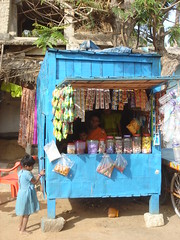
I stay on the other side of the river, which we must reach via motorboat. The older boats, bamboo baskets covered with rice sacks and tar, are no longer in use at this crossing. To cross is 10 Rs each way. At 6pm, the boat magically turns into a pumpkin, leaving princesses and unlucky backpackers both in the lurch. Multiple motorbikes are frequent companions in the smaller, older, boats. Below is our hero, bravely crossing the river by motorized boat.

Hampi is much more quiet and clean than Ahmedadbad. India's formidable population must live primarily in the cities, like people in most contries do. The countryside, then, is quite peaceful.

Here is the initial evidence that we are hot on the trail of the international, but Israeli dominated, backpacker circuit. One can have excellent falafal, schnitzel, Italian, English, and Korean food here. Jachnun, a Yemenite dish, which readers of our blog will remember us eating in Israel, can be found on Shabbat at our guest house restaurant, along with couscous.
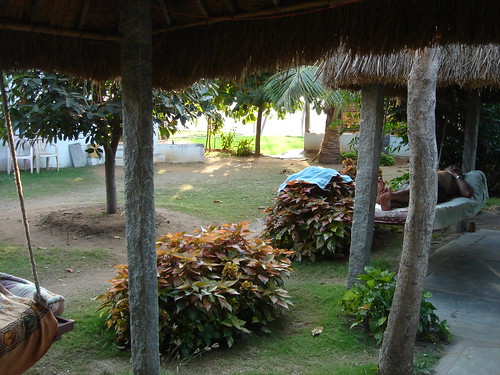
Above, the view from my bungalow's porch. Below, the guest house restaurant, which is run by some really sweet Nepalese folks.
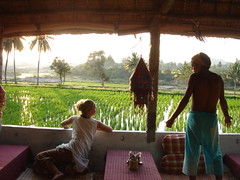
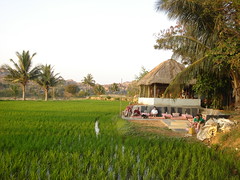
At no added cost, we get some lovely sunsets and lazy mornings with all manner of birds playing around. Below, someone returning home from working in the rice fields.
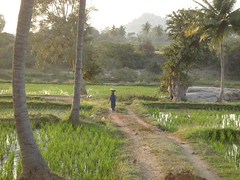
Every evening, we are treated to something like this:
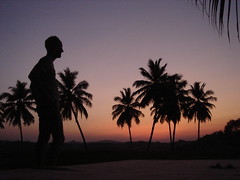
Click through for more pictures. I believe that every evening at least 100 photos are taken of this sunset, meaning about 200mb of sunsets per day, times a 90 day tourist season, is, approximately, 2 gigabytes of photos of these palm trees and sunsets in Hampi every year.

Eager to shower after my long trip, I turn on the hot water and find there is none. I inquire at the front desk, and this steaming bucket shows up. Ok. With the use of a little plastic bucket, whose shape mirrors the large buckets women balance on their heads to transport water home from pumps and wells, I have a hot shower. It isn't as bad as initially expected, and is actually quite nice. One might be cleaner this way, as one focuses first on cleaning, and second on the physical pleasure of hot water. Also, it's nice to be in intimate contact with the physical and material sources and inputs of our lives. Hot water is a luxury for many people on this planet, and it's actual cost and amount consumed is more evident here. The first half of the bucket is for cleaning -- the rest is pure luxury.
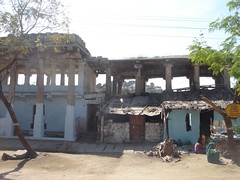
One question this man had about Jerusalem is answered, in part, here. Why would people build on top of one another across thousands of years? I mean, really? A look at this piece of documentation, captured on the main drag of the ancient Hampi bazaar, explains a few things. One can see here some contemporary inhabitants of Hampi freely using the architectural remnants of the ancient stone bazaar. This, of course, makes perfect sense. Why build from scratch, when you can just, say, add a roof, and have a home? It's not How Buildings Learn, but How Cities Learn.
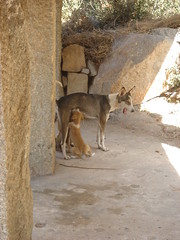
On our first outing into the awesome landscape which surrounds Hampi, filled with boulders and 500 year old temples, we encounter this happy family living in a temple. The mom has just returned home with food for her children. Evidence of having read too much Osamu Tezuka manifested, as an entire story instantly sprang to mind. Young puppies, living on the outskirts of town in the shadow of ancient temples, on a mountain top, wait for their mother to return home with milk. Every day they eagerly await her return, and she seeks out the best scraps of foods to convert into healthy milk. Dal for protein, carrots for vision, and milk for strong bones -- she wants her pups to grow up to be strong. Her husband, their dad, died while defending the temple from an aggressive band of exploitive humans and monkeys. She fights criminals in the town, and is, tragically, killed one day. The eldest pup, who witnessed his mom's death, must come to terms with life here, care for his siblings, defend the temples, and continue fighting the evil that invades this holy place.
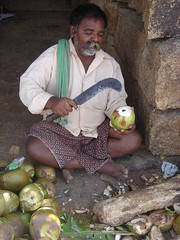

I like coconuts. So do monkeys. And I love monkeys.

Bikes make me happy. Here is our happy hero, riding a bike, clad in his new shirt. The shirt is a 3 for 1: it protects me from sun, helps the air circulate undernearth my clothing, and adds more color to our modest blog's photographs. Above, I am depicted biking around to various temples in the surrounding rural landscape, which is filled with banana tree & rice plantations, temples, and pilgrims. Lots of Hindus travel to these temples. I visited one mosque, which was beautiful, and found myself totally alone.

This picture illustrates a typical Hindu temple, and gives a sense of what the surrounding landscape looks like. I find the endless hills with boulders on them geologically inexplicable. Well, I have some theories, but they aren't worth sharing.
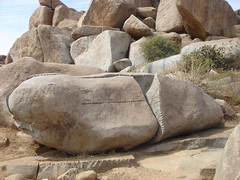
Many boulders have these markings on them, both on hills, and in structures. Evidence, I think, of how they were cut.
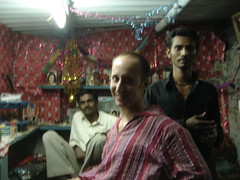
We seek out medical tourism. Here is our protagonist, after having undergone a procedure whereby a large red growth was removed from the facial and cranial parts of his body. The operation, as one can clearly see, was a success. The barber, at right, is 21 or so, and has been working as a barber since the age of 7. The other man let me interrupt his treatment, which can take 30 minutes or more, on account of the meticulous nature of hair removal, massaging, oiling, and so on, so that we could talk. He is a local business man, aged 28, and unmarried -- a bit late for an Indian. But, in a joint Hindu household, the family arranges the marriage, and since it means bringing in a wife and kids, the entire economic circumstances must be considered. Arranged marriages make more sense in this context. A tech worker from Google in Hydrabad informs me, however, that this type of family structure is out of date in most parts of India.
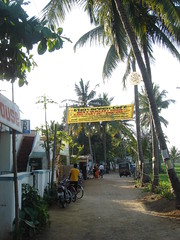
The main Hampi area, and even across the river where I stay, is a bit of a scene. It is filled with backpackers from all over the world, and small children asking for money, candy, and pens. We are hounded by locals for services and goods at every moment.
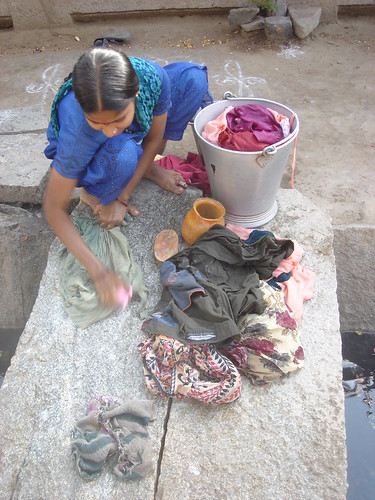
This woman is demonstrating how most people here do their laundry. In the main bazaar, long canals run alongside both sides of the road, directly below the stone arcade. The stone this woman is working on crosses the canal.

Here we are, then, at a more remote village, Anegundi, that is a bit more calm, and free of commercialism. The villagers here are taking part in a common ritual, where we take photos, they examine the digital replay, get excited, and ask for more pictures. This can go on for 10 minutes, easily, and is quite fun. Initially, I photographed them filling up bags of rice for market.
Some small children in Hampi have learned to ask you to take their picture, and then ask for money, chocolate, or other goods. One must be wary of cute 8 year olds asking you to take their picture. Above, Cynthia of Florida, shows a picture to some village ladies.
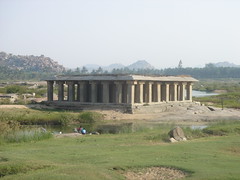
Here is a temple of 64 columns. At the center we have a group of men playing with cards and money. I tried to capture the very cool scene for readers of this blog, but was discouraged from doing so. "Illegal activities," someone waved me away. Readers are encouraged to use their imaginations. Pretty neat, how the columns obscure vision into the temple's center, no?
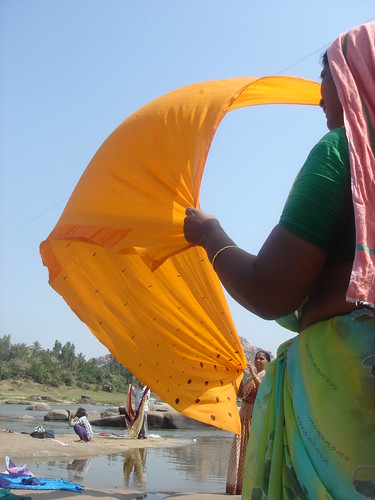
Down in the river, people bathe, and do their laundry. Here, two women dry something colorful.
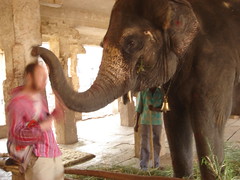
Above we have a most remarkable phemomena. While my physical form might appear, as some would say, blurry, my spiritual form is in fact crystal clear. My physical form visibly vibrates with the emanations from my inner being. I have just received a blessing, or bracha, as the Israelis behind me said, from Lakshmi, the temple elephant. She is, at 20, very young. She likes to eat bananas. To receive a blessing, one must hand her some money, which she grabs with the tip of her trunk. After giving the money to her handler, she delivers a blessing, in the form of a tap, to your head. Highly recommended to all travellers, aged 9 to 90.
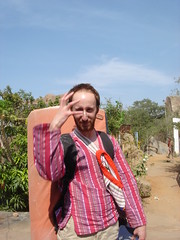
Hampi is well known for its bouldering. Here we are, about to undertake an expedition into the hills of Hampi, a crash pad on our shoulders, and gear in hands. Our team of forensic experts are still hard at work, trying to determine the meaning of this body language. Beggum is a nice lady who has a small house at the end of a lane, and serves some of the most delicious food ever, along with renting out used climbing gear. Some might call the shoes abandoned, as they are in disrepair, and what isn't terribly distressed, certainly won't fit well. Climbers are advised to their own shoes. Duh. I trekked around the hills and met some really sweet climbers, and realized I was seriously out-classed here, in terms of difficulty, shoe quality, and experience climbing outdoors. Luckily, crash pads also make excellent portable couches. Dan, a doctor from England, who also happened to be a sports medicine expert and climber, looked at a climbing injury I sustained in Berkeley, and gave me some exercises to do. Thanks Dan the Doctor!
Readers of this blog find themselves in powerful company. Our readership is rather remarkable, in that great world figures are following our journey, step by step. In Jerusalem, George Bush follows hot on our heels, and in Ahmedabad, the Dali Lama isn't far behind. In Hampi, all the tourists are booted for several days so the Indian President can visit the temples. We are bewildered, and wonder what figure will follow in our footsteps, next. Perhaps we will share a Kerala boat cruise with Putin? That would be interesting, Da?
Stay tuned, as we now make our way back to Goa, in order to meet Alex and Yotam, for what is sure to be a great romp with yet to be announced leaders of world politics, spirituality, and commerce.
